Trojan War › Religion in the Ancient World › Ancient Dvin » Origins and History
Articles and Definitions › Contents
- Trojan War › Ancient History
- Religion in the Ancient World › Antique Origins
- Ancient Dvin › Ancient History
Ancient civilizations › Historical places, and their characters
Trojan War › Ancient History
Definition and Origins
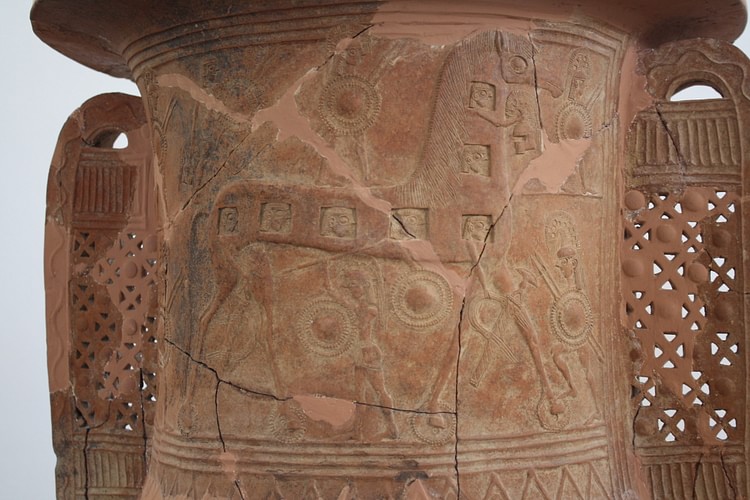
The Trojan War, fought between Greeks and the defenders of the city of Troy in Anatolia sometime in the late Bronze Age, has grabbed the imagination for millennia. A conflict between Mycenaeans and Hittites may well have occurred, but its representation in epic literature such as Homer ’s Iliad is almost certainly more myth than reality. Nevertheless, it has defined and shaped the way ancient Greek culture has been viewed right up to the 21st century CE. The story of gods and heroic warriors is perhaps one of the richest single surviving sources from antiquity and offers insights into the warfare, religion, customs, and attitudes of the ancient Greeks.
PARIS & HELEN
The main source for our knowledge of the Trojan War is Homer's Iliad (written sometime in the 8th century BCE) where he recounts 52 days during the final year of the ten-year conflict. The Greeks imagined the war to have occurred some time in the 13th century BCE. However, the war was also the subject of a long oral tradition prior to Homer's work, and this, combined with other sources such as the fragmentary Epic Cycle poems, give us a more complete picture of what exactly the Greeks thought of as the Trojan War.
The Trojan War, in Greek tradition, started as a way for Zeus to reduce the ever-increasing population of humanity and, more practically, as an expedition to reclaim Helen, wife of Menelaos, King of Sparta and brother of Agamemnon. Helen was abducted by the Trojan prince Paris (also known as Alexandros) and taken as his prize for choosing Aphrodite as the most beautiful goddess in a competition with Athena and Hera at the wedding of Peleus and Thetis. Menelaos and the Greeks wanted her back and to avenge Trojan impudence.
THE GREEK ARMY
The coalition of Greek forces (or Archaians as Homer often calls them) was led by King Agamemnon of Mycenae. Amongst the cities or regions represented were Boiotia, Phocia, Euboea, Athens, Argos, Corinth, Arcadia, Sparta, Kephalonia, Crete, Rhodes, Magnesia, and the Cyclades. Just how many men these totalled is unclear. Homer states an army of 'tens of thousands' or rather more poetically 'as many [men] as the leaves and flowers that come in springtime'.
THE GODS HAD THEIR FAVOURITES AMONGST THE MEN FIGHTING DOWN ON THE PLAINS OF TROY & THEY OFTEN PROTECTED THEM BY DEFLECTING SPEARS.
Amongst the Greek warriors were some extra special heroes, leaders who were the greatest fighters and displayed the greatest courage on the battlefield. Also, they often had a divine mother or father whilst the other parent was a mortal, thereby creating a genealogical link between the gods and ordinary men. Amongst the most important were Achilles, Odysseus, Ajax, Diomedes, Patroklos, Antilokus, Menestheus, and Idomenus.
The Greeks were aided by several of the Olympian gods of Greek religion. Athena, Poseidon, Hera, Hephaistos, Hermes, and Thetis all gave direct or indirect help to the Greeks in Homer's account of the war. The gods had their favourites amongst the men fighting down on the plains of Troy and they often protected them by deflecting spears and even spiriting them away in the heat of battle to put them down somewhere safe, far from danger.
THE TROJAN ARMY
The Trojan army defending the great city of Troy, led by their king Priam, had assistance from a long list of allies. These included the Carians, Halizones, Kaukones, Kikones, Lycians, Maionians, Mysians, Paionians, Paphlagonians, Pelasgians, Phrygians, and Thracians.
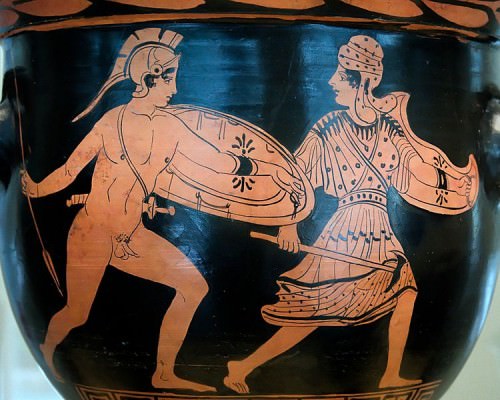
Achilles & Penthesileia
The Trojans, too, had their semi-divine heroes and these included Hektor (son of Priam), Aeneas, Sarpedon, Glaukos, Phorkys, Poulydamas, and Rhesos. The Trojans also had help from the gods, receiving assistance during the battle from Apollo, Aphrodite, Ares, and Leto.
KEY BATTLES
Most of the Trojan War was in a fact a protracted siege, and the city was able to resist the invaders for so long principally because its fortifications were so magnificent. Indeed, in Greek mythology, the walls of Troy were said to have been built by Poseidon and Apollo who, after an act of impiety, were compelled by Zeus to serve the Trojan King Laomedon for one year.There were, though, battles outside the city where armies fought, sometimes with chariots, but mostly by men on foot using spears and swords and protected by a shield, helmet, and armour for the chest and legs. War waged back and forth across the plains of Troy over the years, but the really exciting battles seem to have been reserved for the final year of the siege and the following are a selection of the highlights.
PARIS V MENELAOS
Tiring of indecisive battles, Menelaos offered to fight Paris in single-combat and so settle the issue of the war. Agreeing to this, the two warriors drew lots to see who would have first throw with their spear. Paris won and threw first but his spear landed harmlessly in the shield of Menelaos. The Greek king then threw his weapon with tremendous force and the spear went through the shield of Paris and carried on through to pierce his armour. If Paris had not swayed at the last moment, he would surely have been killed outright. However, Menelaos was not finished and with his sword he struck a fearful blow on the Trojan prince's helmet. The sword shattered, though, and fell in pieces into the dust. Menelaos then grabbed Paris' helmet with his bare hands and proceeded to drag him from the field. Choking as his helmet strap wrapped around his neck, Paris was only saved through the intervention of Aphrodite who broke the helmet strap and, covering the prince in a thick mist, spirited her favourite back to the safety of his perfumed bedroom.
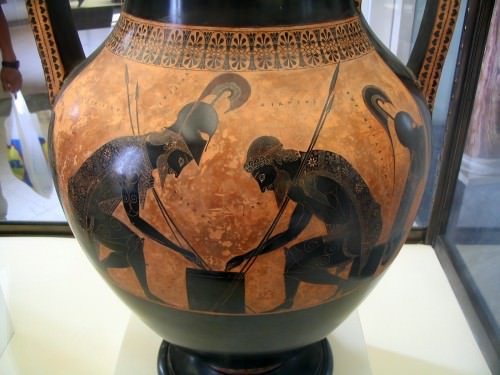
Achilles and Ajax By Exekias
HEKTOR V AJAX
The meeting of the two great heroes echoes that of Menelaos and Paris. Each throw their spears but to no effect. Hektor then threw a large rock at the Greek, only for him to fend it off with his shield. Ajax then returned the favour with an even bigger rock, smashing Hektor's shield. They then drew their swords and closed for mortal combat but were each stopped by their comrades who called for an end to the fighting as night was approaching. Displaying the code of honour for which the good old days were famous, the two warriors even said goodbye on friendly terms by exchanging gifts, Hektor giving a silver -hilted sword and Ajax giving a splendid purple belt.
WITH THE SUPPORT OF APOLLO, AN INSPIRATIONAL HEKTOR, IN HIS FINEST HOUR, ONCE MORE BEAT THE GREEKS BACK TO THEIR SHIPS.
THE GREEK SHIPS ATTACKED
Following a tremendous day of fighting, Hektor led the Trojans in an attack on the very walls of the Greeks' camp. Breaking through the gates, the Trojans sent the Greeks fleeing in panic back to their ships. However, as Zeus was momentarily distracted by the charms of Hera, Poseidon stepped in to encourage the Greeks who rallied and forced the Trojans to retreat.Then the tide of battle changed again and, with the support of Apollo, an inspirational Hektor, in his finest hour, once more beat the Greeks back to their ships where he sought to set them ablaze.
PATROKLOS FALLS
Invincible Achilles was quite simply the greatest warrior in Greece, or anywhere else for that matter. Much to the Greek's frustration, though, he sat out most of the war in a big sulk. Agamemnon had stolen his female war-booty Briseis and consequently the hero refused to fight. Agamemnon at first doesn't seem to have been too bothered about losing his temperamental talisman but as the Trojans started to gain an upper hand in the war, it began to look like Achilles would be needed if the Archaians were to actually win the protracted conflict. Accordingly, an increasingly desperate Agamemnon sent an appeal to Achilles with promises of vast treasure if he would only re-join the conflict. These Achilles refused but with the Greek camp under attack, Patroklos appealed to his mentor and great friend Achilles to rejoin the conflict and, when he still refused, Patroklos asked for permission to wear Achilles' armour and lead the fearful Myrmidons himself. Achilles, on seeing one of the Greek ships already ablaze, reluctantly gave his consent but warned Patroklos to only repel the Trojans from the camp and not pursue them to the walls of Troy.
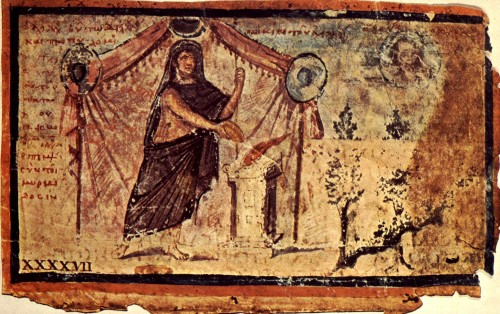
Ambrosian Iliad
ACHILLES' NEW ARMOUR
When Achilles discovered the death of his great friend Patroklos, he was overcome with grief and rage and he swore to take terrible revenge on the Trojans and Hektor in particular. After a suitable show of mourning, Achilles finally decided to enter the battlefield once more. It was a decision which would seal the fate of Troy.
RESPLENDENT IN HIS SHINING ARMOUR, ACHILLES, STILL MAD WITH RAGE, PREDICTABLY ROUTED THE TROJANS.
Before he could enter the fighting, though, Achilles needed new armour and this was provided by his divine mother Thetis who had Hephaistos, the master craftsman of Olympus, make him the most magnificent set of armour ever seen. Using bronze, tin, silver, and gold, the god made a massive shield which depicted a myriad of earthly scenes and all the constellations. So too, he made a dazzling, gold-crested helmet for the hero. Resplendent in his shining armour, Achilles, still mad with rage, predictably routed the Trojans who fled in panic behind the safety of their city walls.
HEKTOR V ACHILLES
Hektor alone remained standing outside the walls but at the sight of the awesome Achilles on the rampage, even his nerve gave way and he made a run for safety. Achilles, however, gave chase and pursued the Trojan prince three times around the city walls. Finally catching him, Achilles killed his quarry with a vicious stab of his spear in Hektor's throat. Achilles then stripped the body of its fine armour and, tying Hektor by the ankles to his chariot, Achilles dragged the body back to the Greek camp in full view of Priam standing atop the fortifications of the city. This was a shockingly dishonourable act and against all the rules of ancient warfare.
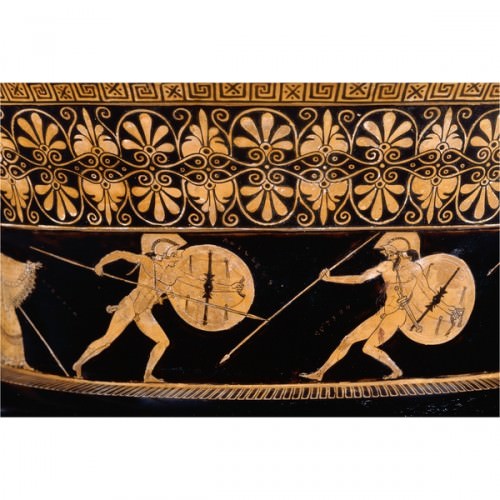
Achilles Fighting Hektor
Having avenged the death of Patroklos, Achilles arranged funeral games in his fallen friend's honour. Meanwhile, Priam entered the Greek camp in disguise and begged Achilles to return the body of his son that he might be given proper burial.Initially reluctant, the emotional pleas of the old man were finally heeded and Achilles consented to return the body. Here the Iliad ends but the war still had a few more twists of fate to turn.
THE TROJAN HORSE & VICTORY
The war involved several more exciting episodes including Achilles' fight with and killing of the Ethiopian King Memnon and the Amazon Penthesilea who both came to the aid of the Trojans. Achilles was even said to have fallen in love with the beautiful Amazon just at the moment he killed her with his spear. Achilles himself met his destiny and was killed by an arrow to his only weak spot, his ankle, shot by Paris and guided by Apollo. Odysseus and Ajax squabbled over the hero's magnificent armour and Ajax went mad with disappointment when he lost out on the prize. Slaughtering a herd of sheep he thought were Greeks, he fell on his sword in a messy and pointless suicide. Philokteles got revenge for his father, Achilles, by fatally shooting Paris with the legendary bow of Hercules. Finally, Odysseus even managed to get into the city in disguise and steal the sacred Palladion statue of Athena.
TROY WAS SACKED & THE POPULATION SLAUGHTERED OR ENSLAVED.
The final and decisive action was, though, the idea of the wooden horse. Odysseus, inspired by Athena, thought up the ruse to get a body of men inside the walls of Troy. First, the Greeks all sailed off into the sunset leaving a mysterious offering to the Trojans of a gigantic wooden horse which in reality concealed a group of warriors within. Just to make sure the Trojans took the horse within the city, Sinon was chosen to stay behind and tell a cock and bull story about the Greeks having given up and left a nice present. The Trojans did take the horse inside the city walls but whilst they were enjoying a drunken celebration of their victory, the Greeks climbed out of the horse, opened the city walls for the returning Greek army, and the city was sacked and the population slaughtered or enslaved. Helen was taken back to Argos and of the Trojan heroes only Aeneas escaped to eventually set up a new home in Italy.
Victory had its price though. Due to their pitiless ravaging of the city and its people and even worse, outrageous sacrilegious acts such as the rape of Kassandra, the gods punished the Greeks by sending storms to wreck their ships and those who did eventually return were made to endure a protracted and difficult voyage home. Even then, some of the Greeks who did make it back to their homeland only did so to face further misfortune and disaster.

The Trojan Horse
TROJAN WAR: ART & LITERATURE
Troy and the Trojan War became a staple myth of Classical Greek and Roman literature and were revisited many times by writers in works such as Aeschylus ' Agamemnon, Euripedes' Trojan Women, and Virgil ’s Aenid. Also in potterydecoration and in sculpture, artists were captivated by the Trojan War. Scenes of the judgement of Paris, Achilles fighting Hektor, Achilles playing dice with Ajax, and Ajax falling on his sword were just some of the myriad scenes from the story that would appear in art again and again over the centuries. Perhaps more importantly, the Trojan War came to represent the struggle of Greeks against foreign powers and it told tales of a time when men were better, more able, and more honourable.
TROY IN ARCHAEOLOGY
There has been much scholarly debate as to whether the mythical Troy actually existed and if so, whether the archaeological site discovered in Anatolia which revealed a city which had prospered over thousands of years of habitation was actually the same city; however, it is now almost universally accepted that the archaeological excavations have revealed the city of Homer's Iliad.
Of the several cities built on top of each other, Troy VI (c. 1750-1300 BCE) is the most likely candidate for the besieged city of Homer's Trojan War. Impressive fortification walls with several towers certainly fit the Homeric description of 'strong-built Troy'.The lower town covers an impressive 270,000 m² protected by an encircling rock-cut ditch and suggests a grand city like the Troy of tradition.
Troy VI was partially destroyed but the exact cause is not known beyond some evidence of fire. Intriguingly, bronze arrowheads, spear tips, and slingshots have been found at the site and even some embedded in the fortification walls, suggesting some sort of conflict. The dates of these (c. 1250 BCE) and the site destruction correlate with Herodotus ' dates for the Trojan War. Conflicts over the centuries between the Mycenaean and Hittite civilizations are more than probable, colonial expansion and control of lucrative trade routes being prime motivators. However, such conflicts are unlikely to have been on the scale of Homer's war, but collectively they may well have been the origin of the epic tale of the Trojan War which has fascinated for centuries.
Religion in the Ancient World › Antique Origins
Definition and Origins
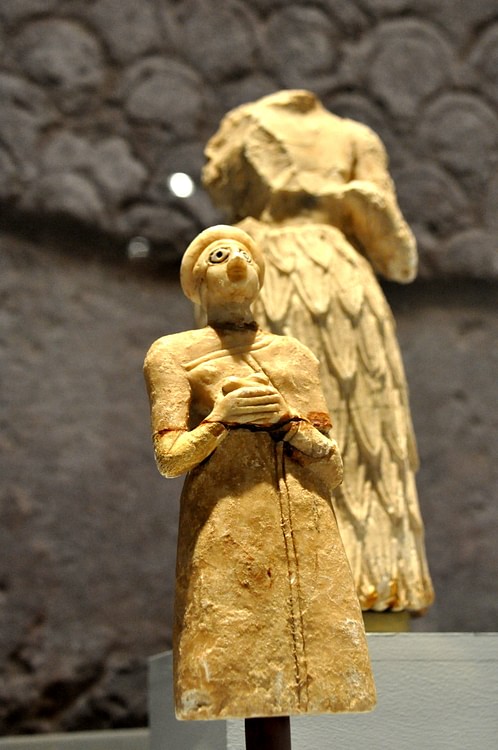
Religion (from the Latin Religio, meaning 'restraint,' or Relegere, according to Cicero, meaning 'to repeat, to read again,' or, most likely, Religionem, 'to show respect for what is sacred') is an organized system of beliefs and practices revolving around, or leading to, a transcendent spiritual experience. There is no culture recorded in human history which has not practiced some form of religion.
In ancient times, religion was indistinguishable from what is known as ' mythology ' in the present day and consisted of regular rituals based on a belief in higher supernatural entities who created and continued to maintain the world and surrounding cosmos. Theses entities were anthropomorphic and behaved in ways which mirrored the values of the culture closely (as in Egypt ) or sometimes engaged in acts antithetical to those values (as one sees with the gods of Greece ).Religion, then and now, concerns itself with the spiritual aspect of the human condition, gods and goddesses (or a single personal god or goddess), the creation of the world, a human being's place in the world, life after death, eternity, and how to escape from suffering in this world or in the next; and every nation has created its own god in its own image and resemblance.The Greek philosopher Xenophanes of Colophon (c. 570-478 BCE) once wrote:
Mortals suppose that the gods are born and have clothes and voices and shapes like their own. But if oxen, horses and lions had hands or could paint with their hands and fashion works as men do, horses would paint horse-like images of gods and oxen oxen-like ones, and each would fashion bodies like their own. The Ethiopians consider the gods flat-nosed and black; the Thracians blue-eyed and red-haired.
Xenophanes believed there was "one god, among gods and men the greatest, not at all like mortals in body or mind" but he was in the minority. Monotheism did not make sense to the ancient people aside from the visionaries and prophets of Judaism.Most people, at least as far as can be discerned from the written and archaeological record, believed in many gods, each of whom had a special sphere of influence. In one's personal life there is not just one other person who provides for one's needs;one interacts with many different kinds of people in order to achieve wholeness and maintain a living.
ANCIENT PEOPLE FELT THAT NO SINGLE GOD COULD POSSIBLY TAKE CARE OF ALL THE NEEDS OF AN INDIVIDUAL.
In the course of one's life in the present day, one will interact with one's parents, siblings, teachers, friends, lovers, employers, doctors, gas station attendants, plumbers, politicians, veterinarians, and so on. No one single person can fill all these roles or supply all of an individual's needs - just as it was in ancient times. In this same way, the ancient people felt that no single god could possibly take care of all the needs of an individual. Just as one would not go to a plumber with one's sick dog, one would not go to a god of war with a problem concerning love. If one were suffering heartbreak, one went to the goddess of love; if one wanted to win at combat, only then would one consult the god of war.
The many gods of the religions of the ancient world fulfilled this function as specialists in their respective areas. In some cultures, a certain god or goddess would become so popular that he or she would transcend the cultural understanding of multiplicity and assume a position so powerful and all-encompassing as almost transform a polytheistic culture into henotheism.

West Pediment of the Parthenon (Reconstruction)
While polytheism means the worship of many gods, henotheism means the worship of one god in many forms. This shift in understanding was extremely rare in the ancient world, and the goddess Isis and god Amun of Egypt are probably the best examples of the complete ascendancy of a deity from one-among-many to the supreme creator and sustainer of the universe recognized in different forms.
As noted, every ancient culture practiced some form of religion, but where religion began cannot be pinpointed with any certainty. The argument over whether Mesopotamian religion inspired that of the Egyptians has gone on for over a century now and is no closer to being resolved than when it began. It is most probable that every culture developed its own belief in supernatural entities to explain natural phenomena (day and night, the seasons) or to help make sense of their lives and the uncertain state humans find themselves in daily.
While it may be an interesting exercise in cultural exchange to attempt tracing the origins of religion, it does not seem a very worthwhile use of one's time, when it seems fairly clear that the religious impulse is simply a part of the human condition and different cultures in different parts of the world could have come to the same conclusions about the meaning of life independently.

Queen of the night (or Burney's) Relief, Mesopotamia
RELIGION IN ANCIENT MESOPOTAMIA
As with many cultural advancements and inventions, the 'cradle of civilization ' Mesopotamia has been cited as the birthplace of religion. When religion developed in Mesopotamia is unknown, but the first written records of religious practice date to c.3500 BCE from Sumer. Mesopotamian religious beliefs held that human beings were co-workers with the gods and labored with them and for them to hold back the forces of chaos which had been checked by the supreme deities at the beginning of time. Order was created out of chaos by the gods and one of the most popular myths illustrating this principle told of the great god Marduk who defeated Tiamat and the forces of chaos to create the world. Historian D. Brendan Nagle writes:
Despite the gods' apparent victory, there was no guarantee that the forces of chaos might not recover their strength and overturn the orderly creation of the gods. Gods and humans alike were involved in the perpetual struggle to restrain the powers of chaos, and they each had their own role to play in this dramatic battle. The responsibility of the dwellers of Mesopotamian cities was to provide the gods with everything they needed to run the world.
THE GODS REPAID HUMANS FOR THEIR SERVICE BY TAKING CARE OF THEIR DAILY NEEDS IN LIFE.
Humans were created, in fact, for this very purpose: to work with and for the gods toward a mutually beneficial end. The claim of some historians that the Mesopotamians were slaves to their gods is untenable because it is quite clear that the people understood their position as co-workers. The gods repaid humans for their service by taking care of their daily needs in life (such as supplying them with beer, the drink of the gods) and maintaining the world in which they lived. These gods intimately knew the needs of the people because they were not distant entities who lived in the heavens but dwelt in homes on earth built for them by their people; these homes were the temples which were raised in every Mesopotamian city.
Temple complexes, dominated by the towering ziggurat, were considered the literal homes of the gods and their statues were fed, bathed, and clothed daily as the priests and priestesses cared for them as one would a king or queen. In the case of Marduk, for example, his statue was carried out of his temple during the festival honoring him and through the city of Babylonso that he could appreciate its beauty while enjoying the fresh air and sunshine.
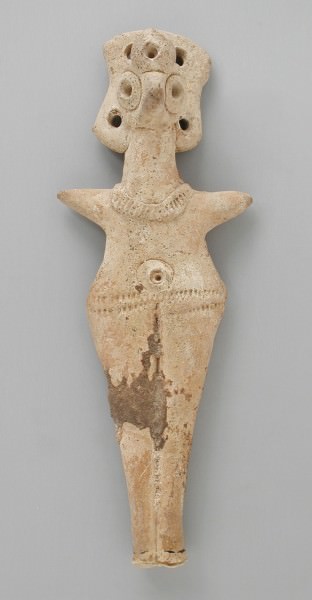
Ishtar
Inanna was another powerful deity who was greatly revered as the goddess of love, sex, and war, and whose priests and priestesses cared for her statue and temple faithfully. Inanna is considered one the earliest examples of the dying-and-reviving god figure who goes down into the underworld and returns to life, bringing fertility and abundance to the land. She was so popular her worship spread across all of Mesopotamia from the southern region of Sumer. She became Ishtar of the Akkadians (and later the Assyrians), Astarte of the Phoenicians, Sauska of the Hurrians - Hittites, and was associated with Aphrodite of the Greeks, Isis of the Egyptians, and Venus of the Romans.
The temples were the center of the city's life throughout Mesopotamian history from the Akkadian Empire (c. 2334-2150 BCE) to the Assyrian (c. 1813-612 BCE) and afterwards. The temple served in multiple capacities: the clergy dispensed grain and surplus goods to the poor, counseled those in need, provided medical services, and sponsored the grand festivals which honored the gods. Although the gods took great care of humans while they lived, the Mesopotamian afterlife was a dreary underworld, located beneath the far mountains, where souls drank stale water from puddles and ate dust for eternity in the 'land of no return.' This bleak view of their eternal home was markedly different from that of the Egyptians.
RELIGION IN EGYPT
Egyptian religion was similar to Mesopotamian belief, however, in that human beings were co-workers with the gods to maintain order. The principle of harmony (known to the Egyptians as ma'at ) was of the highest importance in Egyptian life (and in the afterlife), and their religion was fully integrated into every aspect of existence. Egyptian religion was a combination of magic, mythology, science, medicine, psychiatry, spiritualism, herbology, as well as the modern understanding of 'religion' as belief in a higher power and a life after death. The gods were the friends of human beings and sought only the best for them by providing them with the most perfect of all lands to live in and an eternal home to enjoy when their lives on earth were done.

Chain of Ankhs
The first written records of Egyptian religious practice come from around 3400 BCE in the Predynastic Period in Egypt(c.6000-c.3150 BCE). Deities such as Isis, Osiris, Ptah, Hathor, Atum, Set, Nephthys, and Horus were already established as potent forces to be recognized fairly early on. The Egyptian Creation Myth is similar to the beginning of the Mesopotamian story in that originally there was only chaotic, slow-swirling waters. This ocean was without bounds, depthless, and silent until, upon its surface, there rose a hill of earth (known as the ben-ben, the primordial mound, which, it is thought, the pyramidssymbolize) and the great god Atum (the sun) stood upon the ben-ben and spoke, giving birth to the god Shu (of the air), the goddess Tefnut (of moisture), the god Geb (of earth), and the goddess Nut (of sky). Alongside Atum stood Heka, the personification of magic, and magic ( heka ) gave birth to the universe.
OSIRIS LATER SERVED AS THE SUPREME JUDGE OF THE SOULS OF THE DEAD IN THE HALL OF TRUTH.
Atum had intended Nut as his bride but she fell in love with Geb. Angry with the lovers, Atum separated them by stretching Nut across the sky high away from Geb on the earth. Although the lovers were separated during the day, they came together at night and Nut bore three sons, Osiris, Set, and Horus, and two daughters, Isis and Nephthys. Osiris, as eldest, was announced as 'Lord of all the Earth' when he was born and was given his sister Isis as a wife. Set, consumed by jealousy, hated his brother and killed him to assume the throne. Isis then embalmed her husband's body and, with powerful charms, resurrected Osiris who returned from the dead to bring life to the people of Egypt. Osiris later served as the Supreme Judge of the souls of the dead in the Hall of Truth and, by weighing the heart of the soul in the balances, decided who was granted eternal life.
The Egyptian afterlife was known as the Field of Reeds and was a mirror-image of life on earth down to one's favorite tree and stream and dog. Those that one loved in life would either be waiting when one arrived or would follow after. The Egyptians viewed earthly existence as simply one part of an eternal journey and were so concerned about passing easily to the next phase that they created their elaborate tombs (the pyramids), temples, and funerary inscriptions (the Pyramid Texts, Coffin Texts, and The Egyptian Book of the Dead ) to help the soul's passage from this world to the next.
The gods cared for one after death just as they had in life from the beginning of time. The goddess Qebhet brought water to the thirsty souls in the land of the dead and other goddesses such as Serket and Nephthys cared for and protected the souls as they journeyed to the Field of Reeds. An ancient Egyptian understood that, from birth to death and even after death, the universe had been ordered by the gods and everyone had a place in that order.
RELIGION IN CHINA & INDIA
This principle of order is also paramount in the world's oldest religion still being practiced today: Hinduism (known to adherents as Sanatan Dharma, 'Eternal Order'). Although often viewed as a polytheistic faith, Hinduism is actually henotheistic. There is only one supreme god in Hinduism, Brahma, and all other deities are his aspects and reflections. Since Brahma is too immense a concept for the human mind to comprehend, he presents himself in the many different versions of himself which people recognize as deities such as Vishnu, Shiva, and the many others. The Hindu scriptures number the gods at 330 million, and these range from those who were known at a national level (such as Krishna ) to lesser-known local deities.
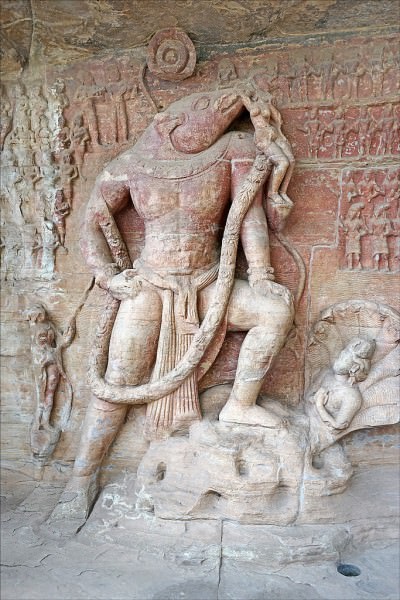
Vishnu as Varaha, Udayagiri Caves
The primary understanding of Hinduism is that there is an order to the universe and every individual has a specific place in that order. Each person on the planet has a duty ( dharma ) which only they can perform. If one acts rightly ( karma ) in the performance of that duty, then one is rewarded by moving closer to the supreme being and eventually becoming one with god;if one does not, then one is reincarnated as many times as it takes to finally understand how to live and draw closer to union with the supreme soul.
This belief was carried over by Siddhartha Gautama when he became the Buddha and founded the religion known as Buddhism. In Buddhism, however, one is not seeking union with a god but with one's higher nature as one leaves behind the illusions of the world which generate suffering and cloud the mind with the fear of loss and death. Buddhism became so popular that it traveled from India to China where it enjoyed equal success.
IN ANCIENT CHINA, RELIGION IS THOUGHT TO HAVE DEVELOPED AS EARLY AS C. 4500 BCE AS EVIDENCED BY DESIGNS ON CERAMICS.
In ancient China, religion is thought to have developed as early as c. 4500 BCE as evidenced by designs on ceramics found at the Neolithic site of Banpo Village. This early belief structure may have been a mix of animism and mythology as these images include recognizable animals and dragons. By the time of the Xia Dynasty (2070-1600 BCE), there were many anthropomorphic gods worshiped with a chief god, Shangti, presiding over all. This belief continued, with modifications, during the period of the Shang Dynasty (1600-1046 BCE) which developed the practice of ancestor worship.
The people believed that Shangti had so many responsibilities that he had become too busy to handle their needs. It was thought that, when a person died, they went to live with the gods and became intermediaries between the people and those gods. Ancestor worship influenced the two great Chinese belief systems of Confucianism and Taoism, both of which made ancestor worship core tenets of their practices. In time, Shangti was replaced with the concept of Tian (heaven), a paradise where the dead would reside eternally in peace.
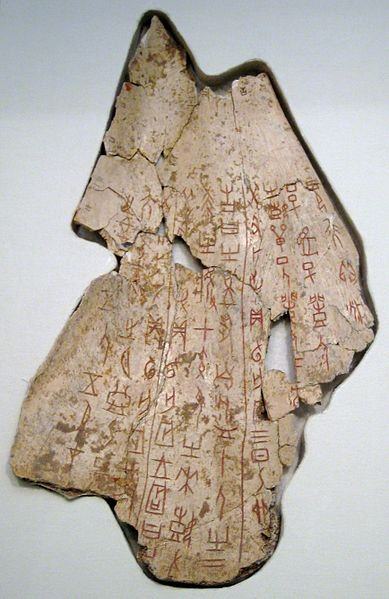
Chinese Oracle Bone
In order to pass from one's earthly life into heaven, one had to cross the bridge of forgetfulness over an abyss and, after looking back on one's life for the last time, drink from a cup which purged all memory. At the bridge, one was either judged worthy of heaven - and so passed on - or unworthy - and slipped from the bridge into the abyss to be swallowed up in hell.Other versions of this same scenario claim the soul was reincarnated after drinking from the cup. Either way, the living were expected to remember the dead who had passed over the bridge to the other side and to honor their memory.
RELIGION IN MESOAMERICA
Remembrance of the dead and the part they still play in the lives of those on earth was an important component of all ancient religions including the belief system of the Maya. The gods were involved in every aspect of the life of the Maya. As with other cultures, there were many different deities (over 250), all of whom had their own special sphere of influence. They controlled the weather, the harvest, they dictated one's mate, presided over every birth, and were present at one's death.
The Mayan afterlife was similar to the Mesopotamian in that it was a dark and dreary place, but the Maya imagined an even worse fate where one was constantly under threat of attack or deception by the demon lords who inhabited the underworld (known as Xibalba or Metnal). The dread of the journey through Xibalba was such a potent cultural force that the Maya are the only known ancient culture to honor a goddess of suicide (named Ixtab) because suicides were thought to bypass Xibalba and go straight to paradise (as did those who died in childbirth or in battle). The Maya believed in the cyclical nature of life, that all things which seem to die simply are transformed, and considered human life just another part of the kind of pattern they saw all around them in nature. They felt death was a natural progression after life and feared the very unnatural possibility that the dead could return to haunt the living.
It was possible that a person would hang on to life for any of a number of reasons (the chief being improper burial ), and so ceremonies were performed to remember the dead and honor their spirit. This belief was also held by Mesoamerican cultures other than the Maya such as the Aztec and Tarascan. In time, it developed into the holiday known today as The Day of the Dead ( El Dia de los Muertos ), in which people celebrate the lives of those who have passed on and remember their names.

Zapotec Priest Figure
It was not only people who were to be remembered and honored, however, but also a very important deity scholars refer to as the Maize God. The Maize god is a dying-and-reviving god figure in the form of Hun Hunahpu who was killed by the Lords of Xibalba, brought back to life by his sons, the Hero Twins, and emerges from the underworld as corn. The 'Tonsured' Maize God or 'Foliated' Maize God are common images found in Maya iconography. He is always pictured as eternally young and handsome with an elongated head like a corncob, long, flowing hair like corn silk, and ornamented with jade to symbolize the corn stalk. He was considered so important by the Maya that mothers would bind the heads of their young sons to flatten the forehead and elongate their heads to resemble him.
The Maize God remained an important deity to the Maya even when eclipsed by the greatest and most popular of the gods Gucumatz (also known as Kukulcan and Quetzalcoatl ) whose great pyramid at Chichen Itza is still visited by millions of people every year in the present day. On the twin equinoxes of every year, the sun casts a shadow on the stairs of the pyramid structure which seems to resemble a great serpent descending from the top to the bottom; this is thought to be the great Kukulcan returning from the heavens to earth to impart his blessings. Even today, people gather at Chichen Itza to witness this event at the equinoxes and to remember the past and hope for the future.
GREEK & ROMAN RELIGION
The importance of remembrance of the dead as part of one's religious devotions was integral to the beliefs of the Greeks as well. Continued remembrance of the dead by the living kept the soul of the deceased alive in the afterlife. The Greeks, like the other cultures mentioned, believed in many gods who often cared for their human charges but, just as often, pursued their own pleasure.
PLATO CONSISTENTLY CRITICIZED THE GREEK CONCEPT OF THE GODS & CRITIAS CLAIMED THEY WERE SIMPLY CREATED BY MEN TO CONTROL OTHER MEN.
The capricious nature of the gods may have contributed to the development of philosophy in Greece as philosophy can only develop in a culture where religion is not providing for the people's spiritual needs. Plato consistently criticized the Greek concept of the gods and Critias claimed they were simply created by men to control other men. Xenophanes, as noted above, claimed the Greek view was completely wrong and God was unimaginable.
Still, to the majority of the Greeks - and central to the function of society - the gods were to be honored and so were those who had passed over into their realm. Just because a person was no longer living on earth did not mean that person was to be forgotten any more than one would forget to honor the invisible gods. As with other ancient cultures, religion in Greece was fully integrated into one's daily life and routine.
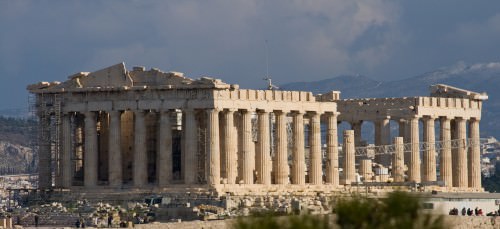
The Parthenon
The Greeks consulted the gods on matters ranging from affairs of state to personal decisions regarding love, marriage, or one's job. An ancient story tells of how the writer Xenophon (430 - c. 354 BCE) went to Socrates asking whether the philosopher thought he should join the army of Cyrus the Younger on campaign to Persia. Socrates sent him to ask the question of the god at Delphi. Instead of asking his original question, Xenophon asked the god of Delphi which of the many gods was best to court favor with to ensure a successful venture and safe return. He appears to have gotten the correct answer since he survived the disastrous campaign of Cyrus and not only returned to Athens but saved the bulk of the army.
The religion of Rome followed the same paradigm as that of Greece. The Roman religion most likely began as a kind of animism and developed as they came into contact with other cultures. The Greeks had the most significant impact on Roman religion, and many of the Roman gods are simply Greek deities with Roman names and slightly altered attributes.
In Rome, the worship of the gods was intimately tied to affairs of state and the stability of the society was thought to rest on how well the people revered the gods and participated in the rituals which honored them. The Vestal Virgins are one famous example of this belief in that these women were counted on to maintain the vows they had taken and perform their duties responsibly in order to continually honor Vesta and all the goddess gave to the people.
Although the Romans had imported their primary gods from Greece, once the Roman religion was established and linked to the welfare of the state, no foreign gods were welcomed. When worship of the popular Egyptian goddess Isis was brought to Rome, Emperor Augustus forbade any temples to be built in her honor or public rites observed in her worship because he felt such attention paid to a foreign deity would undermine the authority of the government and established religious beliefs. To the Romans, the gods had created everything according to their will and maintained the universe in the best way possible and a human being was obligated to show them honor for their gifts.

Vestal Virgin
This was true not only for the 'major' gods of the Roman pantheon but also for the spirits of the home. The penates were earth spirits of the pantry who kept one's home safe and harmonious. One was expected to be thankful for their efforts and remember them upon entering or leaving one's house. Statues of the penates were taken out of the cupboard and set on the table during meals to honor them, and sacrifices were left by the hearth for their enjoyment. If one were diligent in appreciating their efforts, one was rewarded with continued health and happiness and, if one forgot them, one suffered for such ingratitude.Although the religions of other cultures did not have precisely these same kinds of spirits, the recognition of spirits of place - and especially the home - was common.
COMMON THEMES IN ANCIENT RELIGION & THEIR CONTINUANCE
The religions of the ancient world shared many of the same patterns with each other even though the cultures may never have had any contact with each other. The spiritual iconography of the Mayan and Egyptian pyramids has been recognized since the Maya were first brought to the world's attention by John Lloyd Stephens and Frederick Catherwood in the 19th century CE, but the actual belief structures, stories, and most significant figures in ancient mythology are remarkably similar from culture to culture.
In every culture, one finds the same or very similar patterns, which the people found resonant and which gave vitality to their beliefs. These patterns include the existence of many gods who take a personal interest in the lives of people; creation by a supernatural entity who speaks it, fashions it, or commands it into existence; other supernatural beings emanating from the first and greatest one; a supernatural explanation for the creation of the earth and human beings; a relationship between the created humans and their creator god requiring worship and sacrifice.
THERE IS THE REPETITION OF THE FIGURE KNOWN AS THE DYING AND REVIVING GOD, OFTEN A POWERFUL ENTITY HIMSELF, WHO DIES & COMES BACK TO LIFE FOR THE GOOD OF HIS PEOPLE.
There is also the repetition of the figure known as the Dying and Reviving God, often a powerful entity himself, who is killed or dies and comes back to life for the good of his people: Osiris in Egypt, Krishna in India, the Maize God in Mesoamerica, Bacchus in Rome, Attis in Greece, Tammuz in Mesopotamia. There is often an afterlife similar to an earthly existence (Egypt and Greece), antithetical to life on earth (Mesoamerica and Mesopotamia), or a combination of both (China and India).
The resonant spiritual message of these different religions is repeated in texts from Phoenicia (2700 BCE) to Sumer (2100 BCE) to Palestine (1440 BCE) to Greece (800 BCE) to Rome (c. 100 CE) and went on to inform the beliefs of those who came later. This motif is even touched on in Judaism in the figure of Joseph (Genesis 37, 39-45) who is sold by his brothers into slavery in Egypt, goes down into prison following the accusations of Potiphar's wife, and is later released and restored.Although he does not actually die, after his symbolic 'resurrection' he saves the country from famine, providing for the people in the same way as other regenerative figures.
The Phoenician tale of the great god Baal who dies and returns to life to battle the chaos of the god Yamm was already old in 2750 BCE when the city of Tyre was founded (according to Herodotus ) and the Greek story of the dying and reviving god Adonis (c. 600 BCE) was derived from earlier Phoenician tales based on Tammuz which was borrowed by the Sumerians(and later the Persians) in the famous Descent of Inanna myth.
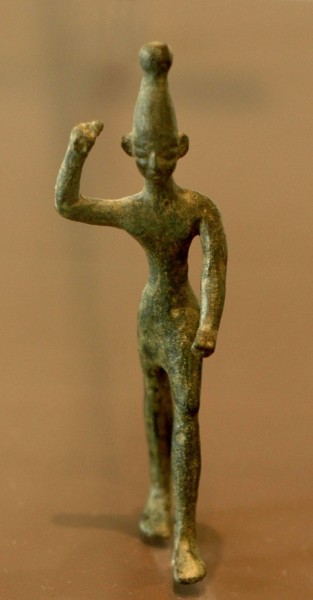
Baal Statue
This theme of life-after-death and life coming from death and, of course, the judgment after death, gained the greatest fame through the evangelical efforts of St. Paul who spread the word of the dying and reviving god Jesus Christ throughout ancient Palestine, Asia Minor, Greece, and Rome (c. 42-62 CE). Paul's vision of the figure of Jesus, the anointed son of God who dies to redeem humanity, was drawn from the earlier belief systems and informed the understanding of the scribes who would write the books which make up the Bible.
The religion of Christianity made standard a belief in an afterlife and set up an organized set of rituals by which an adherent could gain everlasting life. In so doing, the early Christians were simply following in the footsteps of the Sumerians, the Egyptians, the Phoenicians, the Greeks, and the Romans all of whom had their own stylized rituals for the worship of their gods.
After the Christians, the Muslim interpreters of the Koran instituted their own rituals for understanding the supreme deity which, though vastly different in form from those of Christianity, Judaism or any of the older 'pagan' religions, served the same purpose as the rituals once practiced in worship of the Egyptian pantheon over 5,000 years ago: to provide human beings with the understanding that they are not alone in their struggles, suffering, and triumphs, that they can restrain their baser urges, and that death is not the end of existence. The religions of the ancient world provided answers to people's questions about life and death and, in this regard, are no different than those faiths practiced in the world today.
Ancient Dvin › Ancient History
Definition and Origins
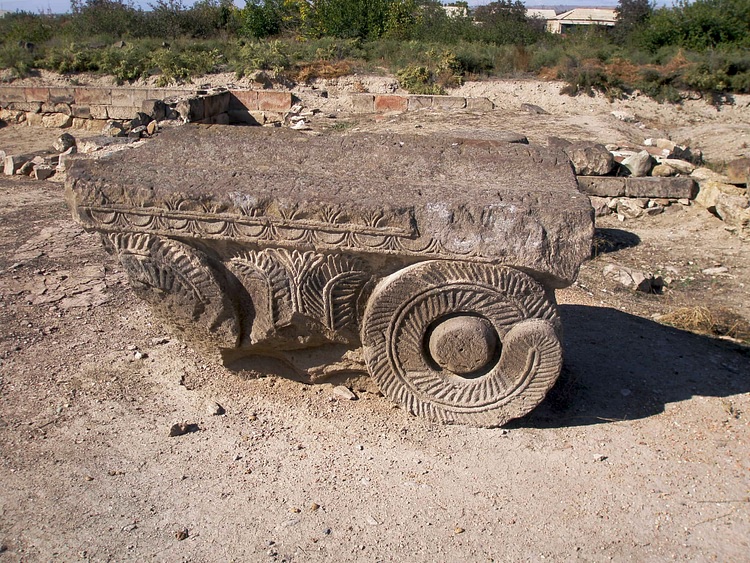
Dvin (aka Duin), located 40 km south of modern Yerevan, was the capital of early medieval Armenia for four centuries.Founded in the 4th century CE, the city prospered and became the administrative head of the Armenian church. Remaining the capital under the rule of the Arab Umayyad Caliphate from the mid-7th century CE, Dvin would ultimately be replaced, first by Partav in 789 CE and then Ani in 961 CE as Armenia's first city.
FOUNDATION
Dvin was founded by the Armenian king Khosrov III Kotak (rc 330 - 338 CE) who converted what was already a small settlement and royal hunting park into a new city. Situated by the Azat (aka Garni) River on a natural promontory, the site was also easily defended with fortification walls built as an additional deterrent. The son of Khosrov, King Tiran, moved the royal residence to Dvin, and by the 5th century CE, it was a thriving city. Its growth was greatly helped by the decision of Armenia's overlords at the time, the Sasanian Empire, to make Dvin the new administrative capital of their part of the country (the other being controlled by the Roman Empire ). Dvin was not without its competitors, though, especially in terms of trade; a notable rival being the former capital and more ancient city of Artashat (Artaxata), located just a few kilometres to the west.
POLITICAL & RELIGIOUS CAPITAL
The move away from the old capital of Vagharshapat was designed to disassociate the new regime from that of the former Armenia ruling dynasty the Arsacid dynasty (12 CE - 428 CE) and increase loyalty to the Persian viceroy or marzpan. Dvin, as the seat of the all-powerful marzpan, was the location of the state's central archives which listed the titles and privileges of Armenia's noble families, many of which were regularly renewed. The archives were also important for the marzpan to assemble the quotas of armed men expected to serve in the Persian army.
THE ADMINISTRATIVE HEAD & ARCHIVAL CENTRE OF THE ARMENIAN CHURCH WOULD REMAIN IN DVIN FOR THE NEXT 450 YEARS.
In religious affairs, too, Dvin took centre stage as the Persians moved the seat of the Armenian Church's first bishop, the katholiko s, there.Esta foi, mais uma vez, parte de uma estratégia para enfraquecer a estrutura religiosa do país. O catholicosate, o chefe administrativo e o centro arquivístico da igreja armênia, permaneceria em Dvin pelos próximos cinco séculos. Uma grande catedral foi construída para o novo status religioso da cidade e dedicada a São Gregório, o Iluminador(c. 239 - c. 330 dC), o primeiro bispo da Armênia em 314 dC. A cidade também possuía muitas belas basílicas e abrigou vários sínodos importantes, notadamente os conselhos de 505 e 554 EC.
UMA CIDADE DE ATRAÇÃO
Dvin benefitted from the surrounding fertile plains which permitted agriculture to thrive, especially animal husbandry and the long-famous Armenian speciality of horse breeding. Natural resources nearby included the necessary raw materials for a successful manufacturing industry in and around the city, weaving and textile products, especially rugs, were produced in large numbers.
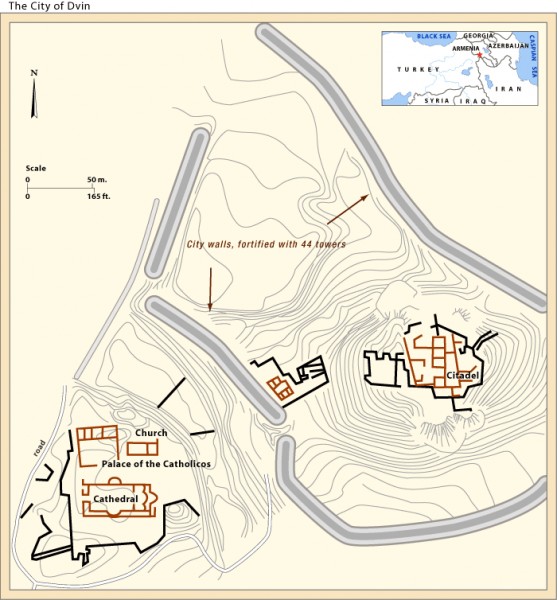
Map of Dvin Archaeological Site
Dvin boasted a cosmopolitan population of over 100,000 residents thanks to the influx of administrators, nobles, merchants, artisans, scholars and clergy. Mixing with the Armenians were Syrians, Jews, Persians, Arabs, Kurds, Turks, and Georgians, amongst others. International long-range traders also took up temporary residence as the city was located on the well-established trade routes between China, India, Persia, and the Mediterranean. Imported goods included silk, spices, medicines, and gems while the major exports were horses, grain, wine, oil, metals, and textiles. The dimensions of the city's trade and its range are attested by the number and variety of coins excavated at the site in modern times.
The Byzantine historian Procopius, writing in the 6th century CE, gives the following description of Dvin's advantages and charms:
Doubios [Dvin] is a land excellent in every respect, and especially blessed with a healthy climate and abundance of good water…In that region there are plains suitable for riding, and many very populous villages are situated in very close proximity to one another, and numerous merchants conduct their business in them. for from India and the neighbouring regions of Iberia and from practically all the nations of Persia and some of those under Romansway they bring in merchandise and carry on their dealings with each other there. (quoted in Hovannisian, 102)
TROUBLED TIMES
As Armenia was perpetually battled over by regional powers for its important strategic position, so, too, wealthy Dvin attracted the covetous ambitions of foreign rulers. In 591 CE a repartition of Armenia was drawn up between the Byzantine Empire and the Sassanids. Under the new agreement, Dvin suddenly became a frontier city between the two spheres of influence and, as a result, disputed territory. A Byzantine army of emperor Heraclius (r. 610-641 CE) attacked Dvin in 623 CE as he sought to expand his empire at the expanse of the Persians, which he did following their crushing defeat at Nineveh in 627 CE. Then, in 636 CE, the new power in the region, the Arab Umayyad Caliphate, won an impressive victory against Heraclius at Yarmak.The Arabs, seemingly risen from nowhere, were led by the brilliant general Khalid who had forged a formidable and highly mobile army using camels, and in October 640 CE he attacked and captured Dvin. Armenia was now part of Umayyad Empire.The Byzantine emperors had not given up on Armenia, and in 642 CE, Constants II (641-668 CE) attacked Dvin but without success. For now, at least, the Arabs ruled the roost in the Caucasus.

Byzantine Empire c. 626 CE
ARAB RULE & LATER HISTORY
The Arabs established a governor of Armenia just like the Sasanids had, only this time his title was vostikan, but his capital remained Dvin for another 150 years. In the first decade of the 8th century CE, Dvin was expanded and refortified with massive buttressed walls and gates, and the whole city was surrounded by a moat. In 789 CE, raids on the frontiers of what was now the Abbasid Caliphate necessitated the removal of the administrative capital to the safer location of Partav. Dvin was thus relegated to the status of the second city of the province of Armenia, even if the Church maintained its headquarters there.
The next big event in the city's history was a disastrous one: the huge earthquake of 892 CE which destroyed much of Dvin and killed tens of thousands of the inhabitants. The catastrophe was the third large earthquake in the region in the last half-century. The katholikos, his palace in ruins, was obliged to move out. With the city and region in chaos, the Sadjid emir of Azerbaijan, Afshin, took advantage and invaded Armenia, easily capturing Dvin, which had neither defences nor defenders.The city was made into a military base and thereafter remained part of various independent emirates, not Armenia proper. Ani was made the capital of Armenia in 961 CE and, after several failed attempts by Armenian kings to recapture Dvin, the city was abandoned to its fate under foreign rule. The city, nevertheless, continued as an important civic centre until its destruction during the Mongol invasion of 1236 CE and definitive abandonment.
This article was made possible with generous support from the National Association for Armenian Studies and Researchand the Knights of Vartan Fund for Armenian Studies.
LICENSE
Article based on information obtained from these sources:with permission from the Website Ancient History Encyclopedia
Content is available under License Creative Commons: Attribution-NonCommercial-ShareAlike 3.0 Unported. CC-BY-NC-SA License